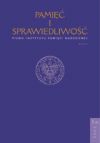Spór o Wierzchowiny. Działalność oddziałów Akcji Specjalnej (Pogotowia Akcji Specjalnej) NSZ w powiatach Chełm, Hrubieszów ...
The dispute about Wierzchowiny. The activity of the troops of Special Action (Emergency of Special Action) National Armed Forces (NSZ) in the Chelm..
Author(s): Mariusz ZajączkowskiSubject(s): History
Published by: Instytut Pamięci Narodowej
Summary/Abstract: The dispute about Wierzchowiny. The activity of the troops of Special Action (Emergency of Special Action) National Armed Forces (NSZ) in the Chelm, Hrubieszów, Krasnystaw and Lubartów districts in light Polish – Ukrainian conflict (August 1944 – June 1945) Spór o Wierzchowiny. Działalność oddziałów Akcji Specjalnej (Pogotowia Akcji Specjalnej) NSZ w powiatach Chełm, Hrubieszów, Krasnystaw i Lubartów na tle konfliktu polsko-ukraińskiego (sierpień 1944 r. – czerwiec 1945 r.) One of the numerous mysterious episodes of Polish – Ukrainian civil war are among others events that took place on 6th June 1945 in the village Wierzchowiny in the Krasnystaw district of Lublin province. Until now it has been a burning issue raising disputes, discussions accompanied by negative emotions, and accusations of ignorance and manipulations of historical facts. The discrepancies concern not only basic issues such as finding the actual perpetrators or settling the real number of Ukrainian victims but also the accurate interpretation of those events. Spring 1945 was the turning point in extremely hostile Polish – Ukrainian relations in Lublin region. In order to meet the expectations of the people tired of a long-lasting Polish – Ukrainian civil war (the conflict escalated in the spring 1944), Home Army-Delegation of Armed Forces (AK-DSZ) and nationalistic Ukrainian underground entered into a local agreement reconciling the sides and stopping unnecessary bloodshed. At the same time the nationalistic wing of Polish underground stated that the ruthless fighting should be continued as a retaliation for Ukrainian attitudes during the war, especially for the so called anti-Polish action by Organisation of Ukrainian Nationalists (OUN) and Ukrainian Insurgent Army (UPA) in Volhynia and Eastern Galicia. Nationalistic wing leaders were also convinced that there was a necessity to make a post-war Poland an ethnically pure country without minorities so numerous until 1939 (Ukrainians being the largest minority group). In spring 1945 the National Armed Forces intensified their activity against the Ukrainians, what violated the agreement concluded by the Home Army-Delegation of Armed Forces and Organisation of Ukrainian Nationalists and Ukrainian Insurgent Army and could have lead to the revival of a conflict and increasing the number of victims on both sides. Moreover, such conduct resulted in deterioration of already strained relations between both freedom organisations tending to become leaders in the fight against the communist security apparatus.
Journal: Pamięć i Sprawiedliwość.
- Issue Year: 9/2006
- Issue No: 1
- Page Range: 265-308
- Page Count: 44
- Language: Polish

